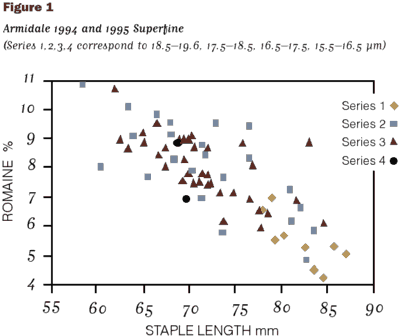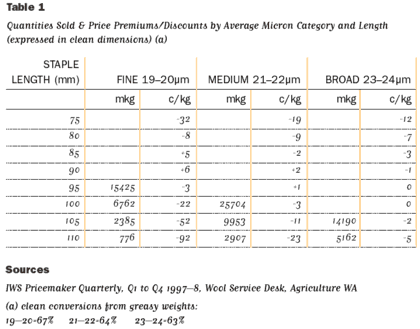
The Wool CRC estimates that the discount currently applied to longer length wools in the marketplace—due to the misconception that such wools are less suitable for spinning—is directly costing Australian woolgrowers more than $7 million per annum1. Indirectly the cost savings in spinning should lead to increased sale of fabric and in turn, greater returns to growers.
Growers are told by wool exporters and brokers that the staple length for fine wools should not exceed 80–85mm (Hauteur of 65–70mm) otherwise there is too much fibre breakage during carding and drafting; and that long Hauteur gives poorer spinning.
These words of advice are misguided. The first claim can be refuted by reference to the CRC Fine Wool project data. For example, the romaine, the percentage of short and entangled fibre removed during combing is shown in Figure 1 as a function of staple length. The longer staple (and lower crimp) wools give rise to less short or broken fibre. The second claim is contradicted by CSIRO research which has shown that longer length tops give enhanced spinning and weaving performance and improved yarn and fabric properties.
Furthermore, the current limits on the allowed coefficient of variation (CVH) of fibre length in the top prevents these longer wools being blended with shorter wools, whereas trials show that CVH has very little effect on yarn properties and spinning performance.
To further debunk these myths that are distorting market prices for longer length wools and thereby penalising growers for no scientifically sound reason, the CRC has begun a project to get long fibre length wools accepted by mills and correctly valued (see Project Description). The key outcomes will be the eventual removal of the discount for long staple length wools and the subsequent improvement in on-farm returns and productivity from the growing of longer length wools.
It is vital that the current beliefs be challenged because breeding for increased fleece weight—the strategy for increasing on-farm productivity and reduced processing costs, and a major objective of the Wool CRC—leads to longer staple length and lower crimp wools. Research to date by the CRC has shown that nutrition, genetics and farm management practices can all contribute to the production of wool with a significant increase in Hauteur. But if this increase in Hauteur goes on being penalised, the potential gains for adopting the research outcomes will not be fully realised, or alternatively growers will respond to the disincentive by returning to less productive on-farm practices and management that produce conventional length wools.
The spinner can gain increases in production from higher speeds or because lower twist levels can be used.


Footnote 1
CRC estimates are based on Woolmark Company data for over-length discounts averaged across four quarters in 1997–98 and data for quantities of wool sold at auction averaged over three seasons 1995–96 to 1997–98, expressed as a fibre diameter/length matrix. The combination of the relevant data is summarised in Table 1. Quantities shown include only wool sold at auction (85%), additionally measured wool (70%) and 19–24 micron wool (price data for 80 mm and a top of 20.5µm and H>83 mm having been selected and are now being commission processed to top at Austop in Parkes. Sub-lots of 200 to 500kg will be spun in four mills in Europe, Japan, North America and India, as well as at the International Fibre Centre in Geelong, in conjunction with wools of normal length and similar diameter. Sample quantities are also to be spun at CSIRO for benchmarking. Assistance will be given to the mills in adjusting their machinery to handle the longer wools. (Note: only minor modifications are required and the spinning frame does not have to be altered.) Spinning and weaving performance and yarn and fabric properties will be compared, feedback will be given to the mills and the benefits of longer wool will be publicised.
Project Description
As a spin-off of this research project, direct links with exporters and spinners will assist in the rapid implementation of other CRC research.
The project relies on substantial in-kind contributions and cooperation from a wool trader (Lempriere), a topmaker (Austop) and the spinning mills, together with contributions from AgWEST, CSIRO Fibre and Textile Technology, International Fibre Centre (IFC) and the Australian Merino Society (AMS). The topmaker has agreed to process the relatively small lots at a concessional tariff. The mills will forward purchase the trial tops (about 400 kg) at a price similar to their conventional tops, bear the costs of spinning and of providing samples and monitoring performance. AgWEST has agreed to contribute $20,000 and the Wool CRC about $25,000 cash, as well as bearing the risk of about $20,000 in the purchase of the 18.5µm wool (AMS is funding the broader wool).
A final report of the trial is expected in early December.
In this issue of The Wool Press: